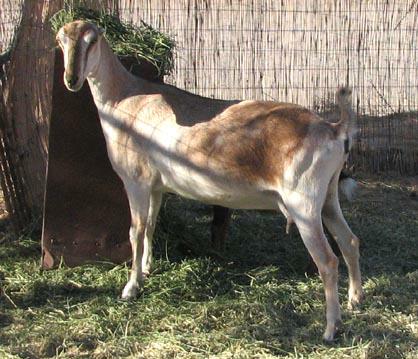LaMancha History
by Terry Thistlethwaite
The tiny eared goat has appeared in numerous countries throughout history. There are even records of such animals dating all the way back to ancient Persia. It was not, however, until their arrival in the United States that a serious attempt to establish these incredible animals as a full fledged dairy breed was undertaken. Amazingly, it soon became apparent to those engaged in this attempt that those little ears seem indelibly attached to a number of superior qualities both dairy and personality related that carry through with genetic dominance.
Short eared dairy goats from Spain were first exhibited at the Paris Goat Show in 1903. These enchanting animals originated in an area called Al Mansha, which is Arabic for dry land. How and when these short eared goats first arrived on American soil is somewhat of a mystery, but we do know that suchlike goats were owned by several prominent California dairy goat breeders early in the twentieth century. Most likely their forebears entered California along with Spanish missionaries during the later part of the nineteenth century. Those early California breeders were reportedly much impressed with the temperament, hardiness, and high quality milk these tiny eared goats rapidly became known for, and interbred them with goats of established breeds within their own herds. Kids resulting from these interbreedings typically carried the short ear trait as well as the more sought after qualities of their outcrossed parentage.
In 1938, Jene and Eula Fey Frey kept a short eared doeling from a Nubian/Alpine cross dam and a short eared sire. The little doeling, named Peggy, was reportedly golden brown in color with curly hair and very large eyes. She would become Fey's favorite pet, and even learned to perform tricks. Peggy, along with another short eared goat of Fey's, named Nesta, would also become the foundation for the American dairy goat breed we now know as the LaMancha.
Peggy and Nesta, along with their offspring, were bred to goats of several different breeds to establish the foundation of the LaMancha breed. Alpine, Toggenburg, French Alpine, and Nubian goats resultantly all hold a place in the LaMancha history.
In 1953, The California LaMancha Breeders Club was formed as the first official organization for the LaMancha Dairy Goat. Mrs. Fay was voted president by a very enthusiastic group of six other fanciers. Just three years later the
American Dairy Goat Association approved the breed and agreed to open a herd book for registry.
By 1957, Fay felt that the new breed had been well established to the point that she was breeding LaManchas to LaManchas exclusively. She developed a breed standard which stated:
"A doe that would be able to produce 3 1/2 to 6 quarts of fine flavored milk with 3.5% or more butterfat over a period of 1-3 years after freshening. She would have the two-way wedge body, strong legs, well placed, udder well attached, both front and back, good barrel, short hair, any color or combination, horned or hornless, and near the size of Toggenburgs."
LaMancha enthusiast Tom Draper, who was voted secretary of the newly formed CLBC, described the breed this way:
"An important characteristic of the LaMancha is her adaptability. She will adapt to any condition or circumstance. She is docile, quiet, loving but independent, a good feeder, congenial in a herd and a steady milker. She is not a flash producer, in fact, you won't notice her especially in the first months, but when your other milkers begin to drop down, she will attract your attention with a steady flow and good fleshing... (You may not react pleasantly to them on sight - but you will when you see how fine they are in behavior, appearance and productivity.)"
On October 15, 1960, The American Dairy Goat Association held their annual banquet and surprised Fay Frey by presenting her with their highest award. The Mary L. Farley Award was given to Fay "In recognition of her years of work in developing the LaMancha breed." Fay, showing her characteristic humility, had to be convinced she was worthy of such an honor.
When Fey Frey died in 1968, her LaMancha herdstock was sold to Harvey Considine, a dairy goat entrepreneur from Wisconsin who had previously purchased goats from Mrs. Frey. Mr. Considine was well taken with the LaMancha breed and their "true American" heritage. He even promoted the idea of cross breeding them to other breeds as a way of improving those breeds. He wrote extensively about their good dispositions, their well deserved reputations as easy keepers, their high production, and superior milk quality. Mr. Considine's enchantment with the breed along with his ability to promote it nationally did much to bring the tiny eared LaMancha to the attention of dairy goat keepers throughout the country.
Today the LaMancha is much heralded as the dairy goat of choice for the small family farmer, homesteader, 4H enthusiast, show fancier, and serious dairy producer. Our made in America breed has established itself as the all around dairy goat par excellence. Those little tiny ears carry with them an enduring history and a promising future.
*Resourced from
Barbara Backus':
The Tale Of The Ear
American LaMancha Club:
History of The LaMancha Dairy Goat
History of the Breed
History of the Breed

